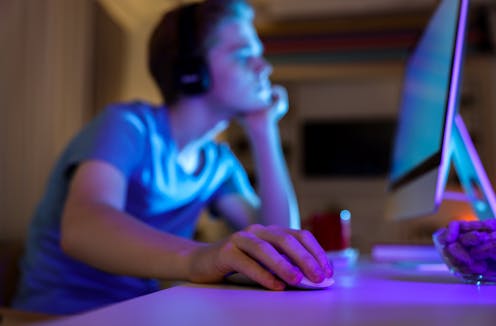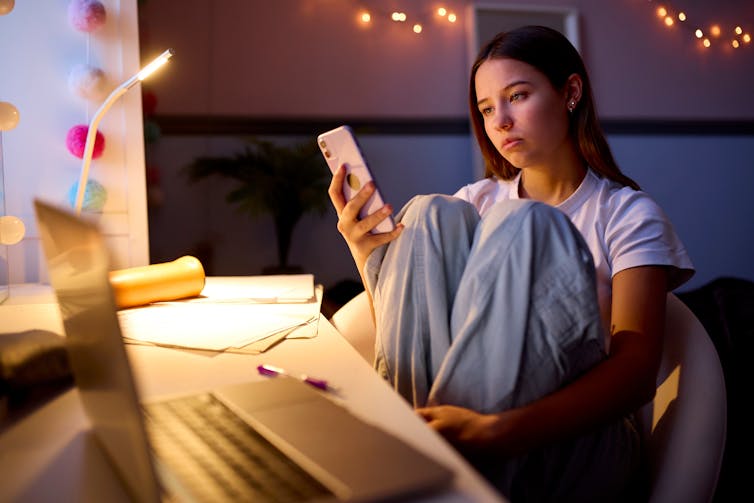
Unlike in previous generations, you’re unlikely to discover your adolescent’s first exposure to adult sexual content from finding a scrunched-up Playboy magazine under their mattress.
With easy access to the internet and the use of tablets and mobile phones, it’s more likely to be from free, mainstream online porn. And it can be a very shocking introduction to sex.
But it’s common and has become normalised among young people. The median age for boys to first view pornography is 13, while for girls it’s 16.
OK, so your child or adolescent has watched a porn video. First, stay calm.
Read more: TikTok has a startling amount of sexual content – and it's way too easy for children to access
Start a discussion about what porn is – and isn’t
How much detail you go into and what’s appropriate for them to know will depend on their age and level of maturity.
Many parents let their adolescents know porn is not real – it’s a fantasy. But it’s not enough to just say, “that’s not real”. They also need to know what reality is.
Explain that porn is not what sex is like – and what’s wrong with depictions of sex in porn: everyone who’s involved should be enjoying it, not just the man.
In porn, you don’t see all the normal things that happen around sex, like discussions on how to ask about consent, or even the bloopers of sex, such as when people change positions, negotiate, and move around.
Porn is not designed to show sex the way it would be experienced as pleasurable, or show what positive relationships are meant to look like. People don’t tend to ask, “do you want to do that?” And if they do, you won’t see what happens if someone says “no”. The performers aren’t doing it in a way that feels good, but instead focus on what is deemed to “look good”.
Porn doesn’t present sex in a real way, and it can change young people’s ideas and expectations about what sex is.
How are adolescents accessing porn?
Adolescents are used to discovering things on their own using the internet and are naturally curious about sex. Their exposure to porn can come from something as simple as googling a term they’ve never heard of before, or their friends sending them a link.
They’re most likely to come across mainstream porn. With lots of flesh, quick movements and closeups, it can be very graphic and can come across as violent to someone seeing it for the first time.
This becomes how adolescents, who don’t have personal experiences of sex, or have the information they need, learn about sex. Just as they go to YouTube to learn how to cook a meal or fix the tap, they are used to watching and following.
And for something private and stigmatised like sex, there are limited good alternatives for them to learn how it really works.

When should we have ‘the talk’?
An open conversation about safety, sex, consent and relationships and gender roles is important throughout their whole life. Introduce the topic of sex gradually, depending on your child’s age. It doesn’t have to be a big sit down, to have a big talk.
It’s best to bring it up in relevant situations, particularly on seeking ongoing consent, because that applies to all aspects of life. Everyone has the right to make decisions about their own body, and it’s up to them if they want to be touched, hugged, kissed or have sex. It’s also important to reinforce that women and girls have feelings and needs, and they’re not just there to look pretty.
Read more: How do you teach a primary school child about consent? You can start with these books
If they’re asking questions, then they’re old enough to talk about it. Ideally, you won’t wait for them to ask. You should be having conversations about consent, positive relationships, and sex from an early age. But it’s important to talk about it earlier rather than later, even if you don’t think they’ve watched porn.
Instead of saying “have you heard about porn?”, let them know from a young age they can trust you if they see something online that they don’t like or confuses them. Assure them you can’t believe everything you see online and you’re a safe person to go to with any questions.
Let them know it’s not their fault if they see something they don’t like, make sure they are OK and ask how it made them feel. Remind them to simply close the browser or turn off the screen if they see something that upsets them or makes them feel yuck.
Can I prevent my child accessing porn?
Your children will probably see porn at some point, but the older they are when they first see it, the better.
Data shows watching porn is associated with poor mental health, riskier sexual behaviours, and attitudes supporting violence against women.
Unlike with adolescents where conversations are paramount, restrictions can prevent and protect young children from seeing porn. These include parental controls on devices, apps or browsers, or establishing rules about when, where and with whom they can access their phones, computers or tablets. Yes, older teenagers can probably get past them, but younger kids can’t.
Read more: Why we need to talk about porn when we talk about Andrew Tate
Be open and honest with your kids about using internet restrictions – don’t spy on them. Let them know why you’re doing it, explaining there are bad things online you need to protect them from – it’s about building trust.
If you find your child showing unusual behaviour or acting out towards other children, or your teen shows signs of addiction (where their viewing activities interfere with their day-to-day lives), seek professional help.
The GIST is a great resource for parents and older teens about how to approach difficult topics like this. If you’re a child or adolescent and need support, you can call the Kids Help Line on 1800 55 1800.
Megan Lim receives funding from the National Health and Medical Research Council, VicHealth, Westpac Foundation, and the Office of the eSafety Commissioner.
This article was originally published on The Conversation. Read the original article.







